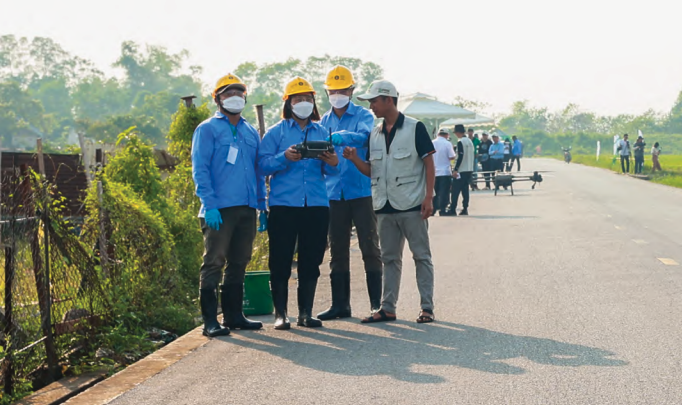Editor’s Note: Each year, exposure to pesticides affects an estimated 3 million farmers, with up to 300,000 fatalities in rural areas of developing countries. In this urgent context, frameworks like the Sustainable Pesticide Management Framework (SPMF) represent critical steps toward safer, science-based pesticide management that protect farmer health, support innovation, and strengthen regulatory systems across diverse agricultural economies.
Across Africa, Asia, and Latin America, countries are rethinking how pesticides are managed to make agricultural systems safer, more efficient, and more responsive to modern needs. At the centre of this shift is CropLife International’s Sustainable Pesticide Management Framework (SPMF), an approach that strengthens national regulatory systems, promotes innovation and ensures responsible pesticide stewardship through science-based guidance, public-private partnerships and tailored country engagement.
The SPMF was developed to address persistent challenges in low- and middle-income countries, where outdated legislation and limited regulatory capacity can create safety risks, stifle innovation and slow agricultural growth. Anchored in the FAO/WHO International Code of Conduct on Pesticide Management, it promotes a holistic, life-cycle approach, covering everything from regulatory reform to farmer training.
The SPMF: a framework built for impact
The SPMF operates through three interlinked pillars:
- Regulatory Reform – Helping governments modernise pesticide legislation and align with international standards.
- Lifecycle Stewardship – Promoting safe use, storage, disposal and resistance management to minimise risks.
- Innovation and Risk Reduction – Supporting access to safer technologies such as biopesticides and drone applications and guiding the phase-out of Highly Hazardous Pesticides (HHPs).
Rather than applying a one-size-fits-all model, the framework works with governments, regulators and local stakeholders to adapt solutions to each country’s agricultural realities and policy priorities.
Solutions in practice
In Africa, SPMF efforts focused on bridging regulatory gaps and laying the groundwork for more resilient, science-based systems. In Kenya, CropLife supported the ongoing implementation of a national HHP roadmap while helping policymakers and industry stakeholders explore policy options for integrated pest management and resistance management. Egypt piloted a national container management initiative and developed new training tools for pesticide inspectors. Meanwhile, Morocco launched a country-specific action plan to address HHPs and began technical work to improve its pesticide registration process.
In Asia, national programs made important strides in digital innovation and lifecycle stewardship. Vietnam moved forward with its digital e-submission system for pesticide registration, which will streamline approvals and improve transparency. Thailand initiated private-sector dialogue on the stewardship of post-patent products and saw tangible results from its ongoing container management projects. Both countries also received support in evaluating biopesticide regulations to create a more innovative and friendly environment.
In Latin America, the focus was on farmer education and integrated regulatory frameworks. Guatemala ramped up its stewardship training and piloted a more formalised system for pesticide incident reporting. In Chile, stakeholders explored regulatory options for drone technology and biopesticides, while continuing efforts to align with Codex standards on maximum residue limits (MRLs).
Driving systemic change through the SPMF
One of the SPMF’s distinguishing features is its commitment to systemic change through local ownership. Rather than prescribing one-size-fits-all solutions, CropLife works with in-country partners to co-develop sustainable systems that will remain in place long after the initial engagement ends.
This includes practical support for building regulatory capacity—such as training programs for inspectors and regulators, the development of guidance documents and tools to improve compliance monitoring. In addition, lifecycle stewardship initiatives have expanded significantly, particularly around safe disposal and container recycling, which are often under-resourced areas.
Importantly, the SPMF also supports the responsible phase-out of HHPs by helping governments evaluate risk, identify alternatives and develop science-based transition plans. These efforts are particularly critical in countries where regulatory systems must balance safety, affordability and access for smallholder farmers.
The power of partnership
The success of the SPMF lies in its collaborative foundation. By fostering strong partnerships with governments, international bodies and local institutions, the framework ensures shared ownership and long-term commitment. This includes aligning with multilateral efforts such as the Global Framework on Chemicals and contributing technical expertise to global dialogues on pesticide risk reduction.
In 2024, the SPMF expanded engagement with regional organisations and launched new initiatives to share lessons learned across countries. The program also supported regional workshops and facilitated knowledge exchange between policymakers, regulators and agricultural stakeholders.
Looking to the future
With global food demand rising and environmental pressures increasing, the need for sustainable, science-based pesticide management has never been more urgent. The SPMF offers a proven model for progress—one that balances innovation, safety and sustainability through practical, locally relevant support.
By empowering governments and farmers with the tools, systems and knowledge they need, the framework is helping countries move from fragmented, outdated pesticide oversight to modern, resilient systems, ensuring that agriculture can thrive without compromising health or the environment.
For more information about the impact of the SPMF and country case studies, read the 2024 SPMF Annual Report.





